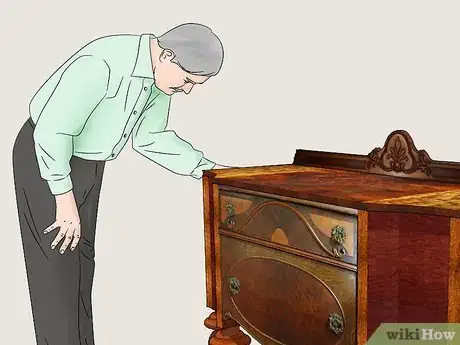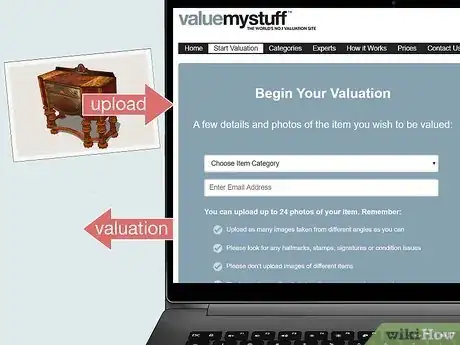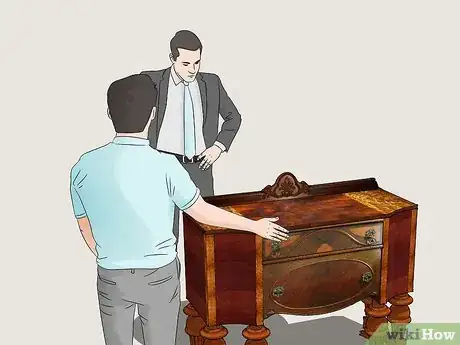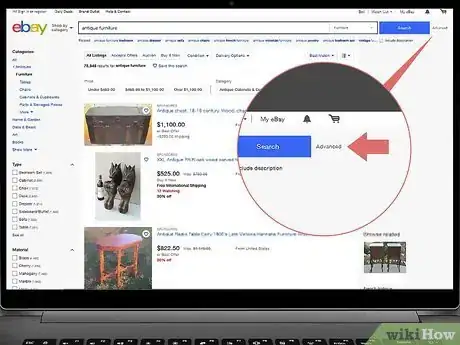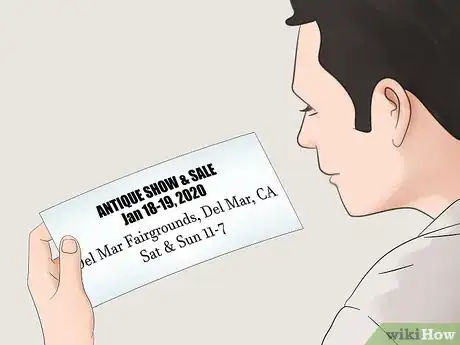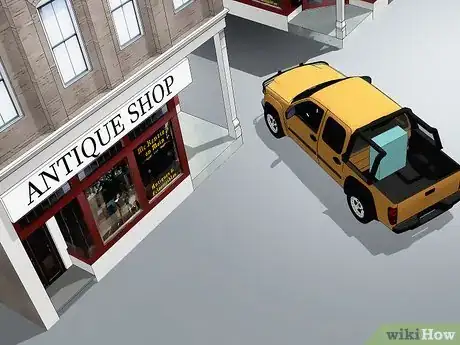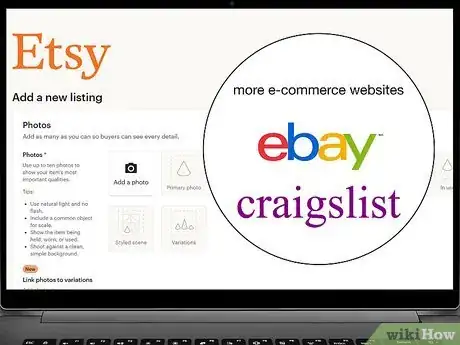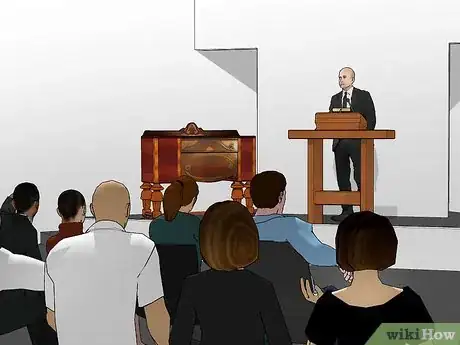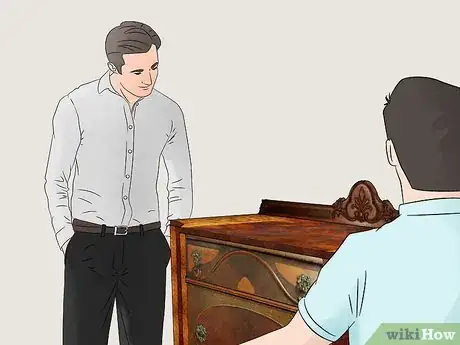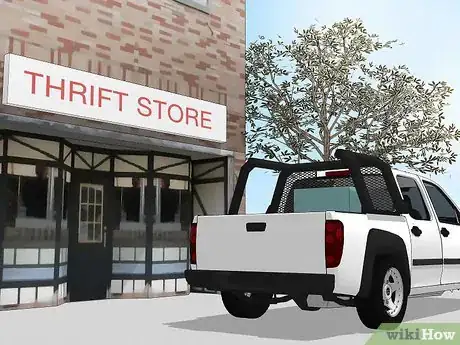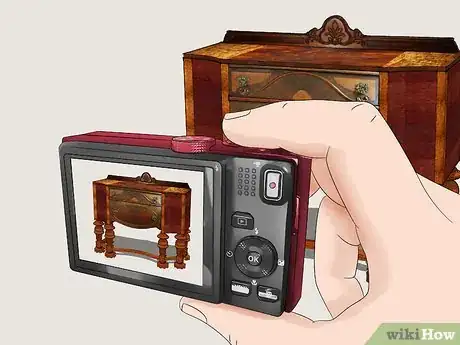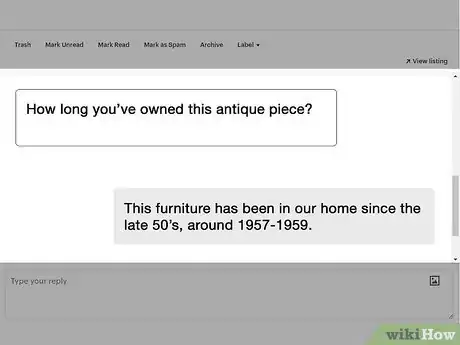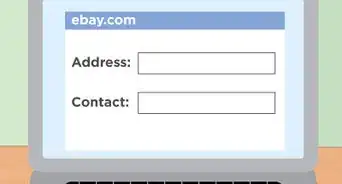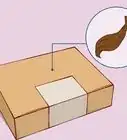This article was co-authored by Tanglewood Sue. Tanglewood Sue is a DIY and Upcycling Specialist and the Owner of Tanglewood Works out of Hyattsville, Maryland. With over nine years of experience, Sue specializes in upcycled painted furniture and other handmade, personalized, and sustainable goods. With her passion for art and reinvention, marketing experience, and Bachelor’s Degree in Broadcast Media, Sue has been able to create a business that not only provides quality pieces but empowers customers to create their works through her library of DIY tutorials and live demos as well as DIY supplies.
There are 14 references cited in this article, which can be found at the bottom of the page.
This article has been viewed 21,959 times.
You’ve finally decided to let go of some of great-great-grandmother’s furniture that’s been collecting dust in your attic for years. But where do you start? Selling antique furniture can be a little tougher than selling smaller antiques, due to its size and constantly changing market conditions. Your best bet is to specifically target people who are in the market for antiques by shopping your items around to antique stores or auction houses, or putting up listings on e-commerce sites like Ruby Lane, Ebay, or Craigslist. If you’re just looking to get rid of a few pieces as quickly as possible, you also have the option of unloading them at a thrift store, flea market, or garage sale.
Steps
Finding out How Much Your Items are Worth
-
1Get your pieces appraised by a professional for a precise estimate. You can track down a qualified antique appraiser near you with a quick Internet search. A certified appraiser will inspect your antique furniture and make determinations about how old it is, who the original maker was, whether it’s genuine or reproduced, and how much it’s currently worth. They’ll then provide you with a document acknowledging the estimated value of your item or items, which you can use to negotiate sales with authority.[1]
- A professional appraisal is recommended if you think that one of your items might be especially rare or valuable.
Warning: Hiring an appraiser could cost you as much as $200-400 per hour, so it may not be the most cost-effective strategy unless you have reason to believe that a certain piece may be worth a lot of money.
-
2Pay for a convenient online appraisal. Websites like Sotheby’s, WorthPoint, and ValueMyStuff allow you to send in photos of your items for a thorough review conducted by a licensed antique appraiser. These appraisals are typically sold in packages that offer various perks, such as the history of a given piece or an official certificate of valuation.[2]
- Web-based appraisals typically start at around $10-20 per piece, making them a much more affordable alternative to hiring a professional antiques appraiser in the flesh.
- For a slightly higher rate, some websites give you the option of signing up for a monthly membership that gives you access to features like instant valuations, detailed sales records, and exclusive pricing guides.
Advertisement -
3Seek a free verbal appraisal from your local auction house. If you don’t have much to spend, see if your local auction house would be willing to value your items for you. Auction houses often hold “valuation days” where in-house appraisers look over antiques brought in by interested parties. These appraisals are generally free of charge.[3]
- Verbal appraisals are the way to go for most newer antiques in decent shape.
- There are both pros and cons to verbal appraisals. On the one hand, they tend to be free, which means they allow you to maximize the profit you stand to make. On the other hand, they don’t come with any kind of certification, which means the average buyer may be skeptical of your asking price.[4]
-
4Research your items yourself using online catalogues and other resources. Study your furniture closely for brand or designer names, unit numbers, and other identifying markings and use this data as the basis for your search. Once you’ve determined the when and where of your piece, browse for it and similar pieces on online antiques databases and marketplaces to get a sense of how much it usually goes for.[5]
- If you’re on Ebay, use the site’s “advanced search” feature to pull up a list of completed sales for similar items. Doing so will clue you in to the item’s actual retail value.[6]
- Be sure to consider factors like the publishing dates of your pricing guides and the average appraisal value of your item as indicated by multiple sources while trying to decide how much to sell it for.
-
5Take your pieces to an antique show to learn more about their history. Keep an eye on your local newspaper and community websites to get the lowdown on when the next traveling antique show is coming to town. There, you’ll have the opportunity to request a verbal appraisal for free (with the price of admission) while also receiving a miniature history lesson on the pieces you bring in.[7]
- Be aware that there may be a limit as to the number of items you can bring to an antique show. It may also be impractical to transport large or heavy pieces back and forth, unless you’re lucky enough to be able to sell them at the venue.
Deciding Where to Sell Your Furniture
-
1Take your pieces to an antique store. Most antique stores get a large part of their stock from private sellers and donors. Take a trip down to your local antique store and talk to the owner or resident appraiser or consignment specialist about possibly brokering a deal. They’ll want to know as much about each piece as possible, so be prepared to provide information like authenticity, age, general condition, and ownership.[8]
- In some cases, you may also be able to get an appraiser from the store to come to your home and look your items over.
- Different antique stores deal in different types of merchandise, so there’s no guarantee that your neighborhood shop will accept the pieces you’re trying to sell.
-
2Put your items up for sale online. E-commerce websites like Ebay, Etsy, and Craigslist can be great places to sell off unwanted antiques, including furniture and other large pieces. Just create a listing that offers a detailed description of each of your items, along with a few high-quality photos showing them off from various angles. Then, set a fair price based on what you think your items are worth.[9]
- List each piece you want to sell separately, unless they’re intended to be part of a set.
- Keep in mind that many websites stipulate that an item must be at least 50 years old in order to qualify as “antique.”
Tip: Sites like Ruby Lane are specifically geared towards antiques, which means your prospective buyers will likely have an idea of what your pieces are actually worth and be willing to pay it.[10]
-
3Submit your antiques to an auction house. Run a quick search for “auction house” plus the name of your city or territory to find an auctioneer in your area that deals with private owners. After a thorough examination, your items will be auctioned off to the highest bidder, and you’ll receive a portion of the proceeds.[11]
- Most of the time, it will be your responsibility to get your items to the venue. Some auction houses may also offer pickup services for an additional charge.
- The money you make from selling your furniture through an auction house will the “hammer price,” or the full amount of the final bid, minus whatever commission and additional fees the auction house levies for their services.[12]
-
4Sell your pieces to a friend or relative who has had their eye on them. If you know someone who’s been admiring a particular item for a while, consider giving them first right of refusal. That way, you won’t have to bother putting up listings online or working out the logistics of getting your piece to an antique store or auction house, and you’ll sleep well at night knowing that it’s destined for a loving home.[13]
- You may not be able to make quite as much money off of your antiques by selling them to a loved one, as they’ll probably expect you to cut them a pretty favorable deal.
-
5Offload your items quickly at a thrift store, flea market, or garage sale. If making a few extra bucks is less important to you than freeing up valuable living space, dropping off your unwanted pieces at may be your best option. These places generally present the lowest potential for profit, but they could be just the avenue you’re looking for if your goal is to get rid of your antiques with minimal time and effort.[14]
- It’s not uncommon for antique aficionados to patrol thrift stores, flea markets, and home sells for rare finds, so there’s no need to drastically undervalue your items.
- Alternatively, you could donate a piece or two to an organization that connects the less fortunate with free and cheap housewares if you feel like doing a good deed.[15]
- One unique benefit of consigning your antique furniture is that there’s a good chance of it actually being used rather than just put on display. It could very well end up beautifying someone’s home and enriching their life.
Making a Successful Sale
-
1Price your pieces fairly according to their estimated worth. When figuring out what to ask for a given item, take into account the findings of any appraisals you had done, as well as your own independent research. If you shelled out for a certified appraisal, you’ll have a reliable figure that you can adjust based on demand. Otherwise, consulting online antique pricing guides completed sales can give you a place to start.
- Try not to let a sentimental connection influence your estimation of what a piece is worth. Antiques are only prized for their objective value, and if you hold out hoping for a fortune, you may never end up letting up.
- If you haven’t got a clue how to price a particular item, another approach is to ask interested parties for their best offer and go with the one who quotes the highest amount.[16]
-
2Take a few clear, high-quality photos of your items. Use a high-quality camera to shoot your pieces from multiple angles, making sure to include close-ups of their manufacturing materials, assembly hardware, and any damage they may have sustained over the years. The camera on your smartphone or tablet should be powerful enough to grab some attractive snaps that showcase the character of your antique furniture.[17]
- Make sure your items are free of dust, spots, fingerprints, and unnecessary clutter before you begin taking pictures.
- Your prospective buyer will always want to evaluate the condition of your items before they agree to buy, whether you’re optioning your items to a local antique store or listing them online.
-
3Report any instances of damage or wear honestly. You may be tempted to try to hide dings, and scratches from your buyer until you’ve completed the transaction, but don’t. Not only is this kind of practice dishonest, it could violate the terms of sale between you and the antique store, auction house, or private buyer you’re doing business with. Remember, honesty is the best policy.[18]
- Documenting major and minor damage will give your buyer a heads-up about what kind of repairs or restorations they might need to arrange once they own a piece.[19]
- You’ll always be able to find someone willing to take antique goods off your hands, no matter what kind of condition they’re in. Disgruntled buyers, however, may post negative reviews about their experiences, which could hurt your reputation as a seller and impact your ability to sell other items in the future.
Tip: If any of your items are in particularly rough shape, have them repaired before you attempt to sell them. A good furniture repairs specialist can do things like re-sew seams, stitch up ripped fabric, and replace stripped screws.
-
4Be prepared to answer any questions your buyer might have about a piece. Part of what makes antiques so coveted is the story behind them—where they came from, who’s owned them, and what they’ve been through. Someone may want to know, for instance, how long you’ve owned a piece, where it’s been stored, or if it has any unique traits that make it more interesting. Do your best to answer questions like these fully and honestly to the best of your knowledge.[20]
- Curious buyers may also be wondering exactly how big a piece is, whether it’s been previously refurbished, or if it came from a home with smokers or pets.
- The more information you can disclose about a particular item, the more confident your buyer will ultimately be in their decision.
References
- ↑ https://www.consumerreports.org/cro/magazine/2012/10/how-much-is-your-stuff-worth/index.htm
- ↑ https://www.consumerreports.org/cro/magazine/2012/10/how-much-is-your-stuff-worth/index.htm
- ↑ https://communications.wellsfargoadvisors.com/lifescapes/cash-attic-value-sell-antiques-collectibles/
- ↑ https://www.pbs.org/wgbh/roadshow/understanding.html
- ↑ https://www.lifestorage.com/blog/storage/whats-worth-find-value-inherited-furniture/
- ↑ https://communications.wellsfargoadvisors.com/lifescapes/cash-attic-value-sell-antiques-collectibles/
- ↑ https://communications.wellsfargoadvisors.com/lifescapes/cash-attic-value-sell-antiques-collectibles/
- ↑ https://wellkeptwallet.com/sell-your-antiques/
- ↑ https://www.antique-hq.com/how-to-sell-antique-furniture-2380/
- ↑ https://wellkeptwallet.com/sell-your-antiques/
- ↑ https://s3.amazonaws.com/cdn.caseantiques.com/wp-content/uploads/2015/03/The-Auction-Consignment-Process_021213.pdf
- ↑ https://www.auctionsneapolitan.com/Auction-Terms-Glossary.html
- ↑ https://www.youtube.com/watch?v=zdw9GXFXxoU&feature=youtu.be&t=41
- ↑ https://www.housebeautiful.com/lifestyle/g22072032/best-flea-markets-in-every-state/
- ↑ https://www.andrewmellen.com/how-to-sell-used-antique-furniture-for-cash/
- ↑ https://www.consumerreports.org/cro/magazine/2014/09/the-best-ways-to-sell-your-stuff/index.htm
- ↑ https://www.thisoldhouse.com/ideas/5-photography-tips-to-help-you-sell-your-used-furniture-online
- ↑ https://www.lifestorage.com/blog/storage/whats-worth-find-value-inherited-furniture/
- ↑ https://www.thisoldhouse.com/ideas/5-photography-tips-to-help-you-sell-your-used-furniture-online
- ↑ https://www.architecturaldigest.com/story/6-steps-to-sell-furniture-online
- ↑ https://www.consumerreports.org/cro/magazine/2014/09/the-best-ways-to-sell-your-stuff/index.htm
